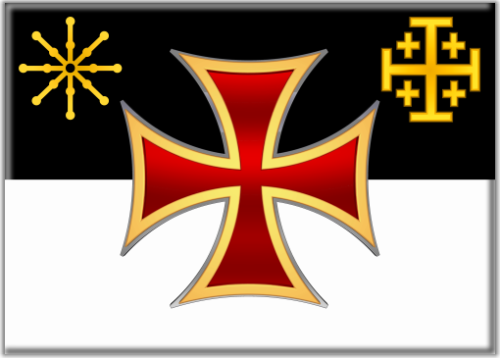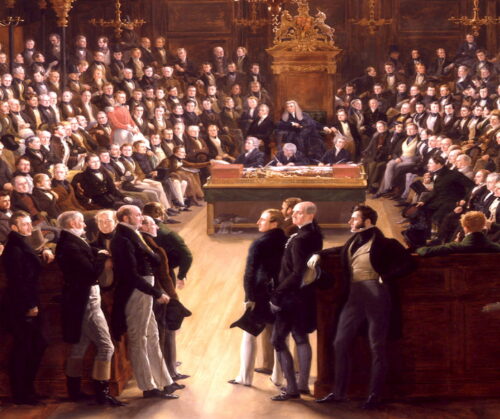
Rediscover the constitutional Government of the original Templar Order as an independent sovereign non-territorial (international) Principality in diplomatic relations, serving as the nation-state for cultural Templarism, governed by the authentic Templar principles of egalitarian meritocracy.
 An essential part of “lost” history of the Knights Templar (now “found”), is the fact that the Templar Order actually had full sovereignty of statehood, as a non-territorial (international) Principality. As a result, it necessarily had official status of its own Government, for governance of the Order, and to engage in diplomatic relations among nation-states.
An essential part of “lost” history of the Knights Templar (now “found”), is the fact that the Templar Order actually had full sovereignty of statehood, as a non-territorial (international) Principality. As a result, it necessarily had official status of its own Government, for governance of the Order, and to engage in diplomatic relations among nation-states.
This legal status of sovereignty was an important resource to strengthen the capabilities of the Order to effectively serve as Guardians of major world heritage, Defenders of Faith, and Law Givers of Justice and Common Law rights.
The true history of the Templar Order being its own Government has been mostly forgotten:
First, this was caused from the 12th century by Templar modesty and humility, because the Order never asserted its sovereignty publicly, but only privately among kings;
Finally, its official status was obscured since the 15th century by private fraternities presenting Templar themes as if the Order were merely a private club or society.
With the full restoration of the original institution of the founding Knights Templar, is necessary in the modern era for the Order to reclaim and publicly reassert its historical Government authority.
A concise summary of the most relevant facts and evidence from the historical record, proving the reality and legitimacy of the Templar Government, is presented here below.
![]()


Independence – In 1118 AD, the Templar Order was originally granted Royal patronage with autonomous sovereignty by the Kingdom of Jerusalem ((Collier’s Encyclopedia, Thomson Gale (1985), 1985 Edition, Macmillan Library Reference (1990), “Knights Templars”.)) ((Charles G. Addison, The History of the Knights Templar (1842), pp.4-5, citing a Vatican document by the 13th century Pope Urban IV (Jacques Pantaleon, 1195-1264), the Latin Patriarch of Jerusalem, as “Pantaleon, Lib. iii. p. 82.”)) ((The Vatican, The Catholic Encyclopedia (1912), The Encyclopedia Press, New York (1913), Volume 14, “Templars, Knights”, Part 1, “Their Humble Beginning”, p.493)) ((Ernoul & Bernard, Chronique d’Ernoul et de Bernard le Tresorier (ca. 1188), Ed. L. de Mas Latrie, Paris (1871), Chapter 2, pp.7-8.)), including rights “in perpetuity” ((William of Tyre, Historia Rerum in Partibus Transmarinis Gestarum (ca. 1172 AD), XII, 7, Patrologia Latina, 201, 526-27, Translated by James Brundage, The Crusades: A Documentary History, Marquette University Press, Milwaukee (1962), pp.70-73.)), such that “the Templars were not directly responsible to any secular monarch” ((Malcolm Barber & Keith Bate, The Templars: Selected Sources, Manchester University Press (2002), p.5.)), nor to any Church ((Ernoul & Bernard, Chronique d’Ernoul et de Bernard le Tresorier (ca. 1188), Ed. L. de Mas Latrie, Paris (1871), Chapter 2, pp.7-8.)).


Official heraldic coat of arms of the Government of the Templar Order as a non-territorial Principality and sovereign subject of international law
Sovereignty – In 1120 AD, the Kingdom elevated this founding grant to full Royal Protection granting permanent independent sovereignty at the Council of Nablus ((Kingdom of Jerusalem, Council of Nablus: Concordat of Canons (1120 AD), established by Patriarch Warmund and Kind Baldwin II of the Kingdom of Jerusalem; Preserved in the Sidon Manuscript, Vatican Library, MS Vat. Lat. 1345: “Introduction to Canons”; Canon 20.)) ((Hans E. Mayer, The Concordat of Nablus, The Journal of Ecclesiastical History, Cambridge University Press, No. 33 (October 1982), pp.531-533, 541-542.)) ((Dominic Selwood, Quidem Autem Dubitaverunt: The Saint, the Sinner, the Temple; Published in: M. Balard (Editor), Autour de la Première Croisade, Publications de la Sorbonne, Paris (1996), pp.221-230.)) ((Dominic Selwood, Knights Templar III: Birth of the Order (2013), historian for Daily Telegraph of London, article.)) ((Malcolm Barber, The Trial of the Templars, Cambridge University Press (1978), p.5, p.8.)) ((Malcolm Barber & Keith Bate, The Templars: Selected Sources, Manchester University Press (2002), p.5.)).
Principality – In 1129 AD, the Kingdom granted the Order governance of three major Templar Principalities of Edessa, Tripoli and Antioch, giving the Templar Governors co-regency as “Prince” ((Steven Runciman, A History of the Crusades, Volume 2: “The Kingdom of Jerusalem”, Cambridge University Press (1952), pp.212-213, 222-224.)).
Under customary international law, a Kingdom or Principality retains its sovereignty, diplomatic and governmental status, even after losing its territories, as an “independent non-territorial power” ((International Commission for Orders of Chivalry (ICOC), Report of the Commission Internationale Permanente d’Études des Ordres de Chevalerie, “Registre des Ordres de Chivalerie”, The Armorial, Edinburgh (1978), Gryfons Publishers, USA (1996), including: Principles Involved in Assessing the Validity of Orders of Chivalry (1963), Principle 2, Principle 3, Principle 6.)).
Confirmation – Ten years later, the Templar Order was granted additional Sovereign Protection of permanent and irrevocable sovereignty with full independence by a Vatican Papal Bull in 1139 AD ((Pope Innocent II, Omne Datum Optimum (29 March 1139), translated in: Malcolm Barber & Keith Bate, The Templars: Selected Sources, Manchester University Press (2002), p.8, pp.59-64: “Master of the Religious Order of the Knighthood of the Temple… and his successors… in perpetuity… the protection and tutelage of the Holy See for all time to come.”; “not only in your Principal [princely] house but also in your dependencies and places subject to them… for ever the head and ruler of all those places belonging to it… [which] may not be infringed nor diminished by any ecclesiastical or secular person.”)), reconfirmed by supporting Papal Bulls in 1144 AD ((Pope Celestine II, Milites Templi, “Knights of the Temple” (5 January 1144), translated in: Malcolm Barber & Keith Bate, The Templars: Selected Sources, Manchester University Press (2002), pp.8, 64-65.)) and 1145 AD ((Pope Eugenius III, Militia Dei, “Knighthood of God” (7 April 1145), translated in: Malcolm Barber & Keith Bate, The Templars: Selected Sources, Manchester University Press (2002), pp.8, 65-66.)).
As a result of these multiple grants establishing and recognizing its official powers and authorities, the original Templar Order has remained a sovereign non-territorial (international) Principality, with its own Government.
Used Privately – Official Vatican records confirm that the Templar Order did in fact possess and exercise its independent non-territorial sovereignty of statehood, quietly and privately, only in its diplomatic relations with other historical institutions ((The Vatican, The Catholic Encyclopedia (1911), The Encyclopedia Press, New York (1913), Volume 8, “Jerusalem”, p.363.)) ((The Vatican, The Catholic Encyclopedia (1912), The Encyclopedia Press, New York (1913), Volume 14, “Templars, Knights”, Part 2, “Their Marvellous Growth”, pp.493-494.)).
Legal Succession – The Sovereign Magistral Order of the Temple of Solomon was restored to its full legal legitimacy of sovereignty by historical rules of continuity and succession ((Hans J. Hoegen Dijkhof, Hendrik Johannes, The Legitimacy of Orders of St. John: A Historical and Legal Analysis and Case Study of a Para-religious Phenomenon, Hoegen Dijkhof Advocaten, Universiteit Leiden (2006).)), officially reestablishing its original Grand Mastery by proven legal and canonical precedent ((Ambassadeur Géraud Michel de Pierredon, Histoire Politique de l’Ordre Souverain de Saint-Jean de Jerusalem (Ordre de Malte), Paris (1926), Tome 5.)) ((Saint Michael Academy of Eschatology, Regular Orders of the Holy See, West Palm Beach, Florida (2008), updated (2015), Free Course No.555: “Chivalric Orders”, Lesson 3, Part 4, “The Order After the Loss of Jerusalem to the French”.)) in 2013 AD, by rules which remain in full force as customary international law ((Vienna Convention on Diplomatic Relations (1961), Preamble, Article 47.1.)) ((Vienna Convention on Consular Relations (1963), Preamble.)) ((New York Convention on Jurisdictional Immunities of States (2004), Preamble: ¶5.)) ((Vienna Convention on the Law of Treaties (1969), Preamble, Article 38.)) which are binding upon all countries ((Vienna Convention on the Law of Treaties (1969), Article 38.)).
Diplomatic Status – As a non-territorial (international) Principality, the modern Templar Order legally holds the status of a “sovereign subject of international law” ((Rebecca Wallace, International Law: A Student Introduction, 2nd Edition, Sweet & Maxwell (1986).)) ((Vienna Convention on the Law of Treaties (1969), Article 3.)) based upon its authentic substance ((Vatican, Tribunal e Cardinalizi o Constituito con Pontifico Chirografo (10 December 1951), Acta Apostolicae Sedis (24 January 1953), XLV (15): 765-767.)). As the state representing the “nationality” of cultural Templarism in world affairs, it is sometimes also properly referred to as a “nation-state”. The Order thereby inherently possesses full Diplomatic status for official international relations ((Vienna Convention on Diplomatic Relations (1961), Preamble; Vienna Convention on Consular Relations (1963), Preamble; New York Convention on Jurisdictional Immunities of States (2004), Preamble: ¶5: All recognizing the “status of diplomatic agents” from all forms of nation states “since ancient times”, including historical sovereign entities of “differing constitutional and social systems”.)) ((Vienna Convention on the Law of Treaties (1969), Articles 3, 38: Status as a sovereign “subject of international law” is binding upon all countries regardless of recognition; Vienna Convention on Consular Relations (1963), Article 47.1; New York Charter of Economic Rights of States (1974), Preamble: ¶3, ¶7, Article 4: Countries “shall not discriminate” against a historical form of nation state.)).
As a result of these (and many more) proven legal facts, the restored Ancient Order of Knights of the Temple lawfully has a legitimate constitutional and parliamentary Government, possessing official capacity to exercise all functions of statehood and diplomacy in international relations.
![]()
![]()
![]()
![]()
![]()
![]()
![]()
![]()
![]()




Official Flag of the Order of Knights of the Temple as an independent non-territorial Principality and sovereign subject of international law
Historically, the Grand Mastery and Government of the Order have always worked together as an egalitarian meritocracy, with all officials coming to the table as equals. It was precisely this tradition which was famously described as the “Knights of the Round Table” of medieval Arthurian legends, which were written and popularized by the Knights Templar themselves ((Alan Butler and Stephen Dafoe, The Warriors and the Bankers, Lewis Masonic, Surrey, England (2006), pp.56-57.)) ((Frank Sanello, The Knights Templars: God’s Warriors, the Devil’s Bankers, Taylor Trade Publishing, Oxford (2003), p.278.)).
Accordingly, the Templar Order de-emphasizes individual personalities, and does not support the dominating influence of any particular individuals, strictly following the historical Templar motto “Non nobis Domine, sed nomini Tuo da gloriam”, meaning “Not to us, Lord, by to Thy name give the glory” ((Old Testament, Authorized King James Version (AKJV), Cambridge University Press (1990), Psalm 115:1.)).
Upholding these core principles, the Government of the Templar Principality does not “rule” nor impose “governance” over its members or participating organizations. Rather, it serves to represent its membership, representing the national identity of cultural Templarism, while guiding the historical institution by its original doctrines as proven by the historical record.
Indeed, this must be the necessary function of any true “government” – to listen to and faithfully represent the rights and interests of its people, while guiding its public policy by time-tested humanitarian principles of human rights.
All members and participating organizations simply agree to abide by the Acts & Laws established by the Templar Government, as a contractual condition of interacting with and benefitting from this venerable historical institution.
![]()
![]()
![]()
![]()
![]()
![]()
![]()
![]()
![]()


The Templar Government engages in diplomatic relations primarily through inter-governmental organization (IGO) institutions, which are supported by Knights and Dames of the Order. These relations concentrate on supporting the Non-Aligned Movement (NAM) of free and independent countries.


‘The House of Commons’ (1833 AD) by Sir George Hayter, in British National Portrait Gallery (Detail)
It also engages in bilateral diplomatic relations with a wide range of individual sovereign states, primarily through private official Envoys.
Confidential Relations – Diplomatic protocol requires mandatory confidentiality of all communications with other States. This prohibits the Templar Order disclosing details of its diplomatic relations:
Under the 1961 Convention on Diplomatic Relations, all States are required to “protect free communication” by other States “for all official purposes” (Article 27.1), and thus “all correspondence” is classified as confidential, and “shall be inviolable” (Article 27.2).
Official Cooperation – The Templar Government develops and strengthens its diplomatic relations by providing strategic support and institutional resources, through its Crown Officers and appointed Ambassadors assisting and cooperating with various affiliated IGO institutions and their Member States.
The Templar Order thus demonstrates leadership in the international community, by providing the ancient keys of the pillars of civilization, as the time-tested solutions to many modern problems.
![]()
![]()
![]()
![]()
![]()
![]()
![]()
![]()
![]()



The Templar Order is historically – and again currently – one of the leading Member States of the Royal Alliance of Independent States (RAIS), an ancient treaty alliance established ca. 16,000 BC, supporting a network of kingdoms of major world heritage.
The Order is also one of the founding Member States of the inter-governmental organization (IGO) Ignita Veritas United (IVU), backed by the ancient Royal Alliance, serving as the infrastructure for diplomatic relations of the Alliance with modern States in conventional international law.
These diplomatic memberships give the Templar State and its Government official recognition, and also strong cooperation, for the Order to reassert its legendary positive influence in world affairs.
![]()
![]()
![]()
![]()
![]()
![]()
![]()
![]()
![]()


That has popularized a misconception, which frequently causes people to ask if an Order of Chivalry has “UN Recognition”, supposedly to confirm legitimacy.
However, the United Nations has no legal standing, no jurisdiction, and no authority to “recognize” the sovereignty of a Kingdom or Principality, nor legitimacy of a nobiliary Order of Chivalry, because the UN itself does not possess any related status of royalty, nobility or chivalry.
Under customary international law, an inter-governmental institution founded only by modern secular republics cannot grant any valid “recognition” to an Order of Chivalry, because it lacks its own source of royal, nobiliary or chivalric authority.
A Common Law precedent doctrine establishes that only an institution of royalty, nobility or chivalry has jurisdiction to recognize or declare the status of another institution of royalty, nobility or chivalry:
“A court having jurisdiction… [for] heraldry… precedence, and the like” as matters of royalty, nobility and chivalry, “was one of the functions of the Court of Chivalry… [to] act as a court of honor.” ((Henry Campbell Black, M.A., Black’s Law Dictionary, 2nd Edition, West Publishing Co., Saint Paul, Minnesota (1910), “Court of Honor”, p.289; Common Law precedent doctrine that only royalty has jurisdiction to deal with other royalty:))
Nobiliary law experts confirmed this rule, further explained as follows:
“The recognition of Orders by [modern] States… cannot be accepted as constituting validation by sovereignties” because they have “renounced… Heraldic Jurisdiction” by themselves having no royalty or nobility. ((International Commission for Orders of Chivalry (ICOC), Report of the Commission Internationale Permanente d’Études des Ordres de Chevalerie, “Registre des Ordres de Chivalerie”, The Armorial, Edinburgh (1978), Gryfons Publishers, USA (1996), including: Principles Involved in Assessing the Validity of Orders of Chivalry (1963), Principle 5.)) ((Hans J. Hoegen Dijkhof, Hendrik Johannes, The Legitimacy of Orders of St. John: A Historical and Legal Analysis and Case Study of a Para-religious Phenomenon, Hoegen Dijkhof Advocaten, Universiteit Leiden (2006), p.416.))
Therefore, the restored original Templar Order does not require any recognition by nor affiliation with the United Nations, to exercise its own proven diplomatic status, as recognized by a network of kingdoms in international relations.
![]()
![]()
![]()
![]()
![]()
![]()
![]()
![]()
![]()
The Head of State of the Order as a sovereign subject of international law is the Prince Grand Master of the Order as a historical institution. As Sovereign Head of State, the Grand Master holds the inherent sovereign, chivalric and ecclesiastical Fons Honourum which is vested in the Order itself in its own right ((Hans J. Hoegen Dijkhof, Hendrik Johannes, The Legitimacy of Orders of St. John: A Historical and Legal Analysis and Case Study of a Para-religious Phenomenon, Hoegen Dijkhof Advocaten, Universiteit Leiden (2006), p.36.)) ((Hans J. Hoegen Dijkhof, Hendrik Johannes, The Legitimacy of Orders of St. John: A Historical and Legal Analysis and Case Study of a Para-religious Phenomenon, Hoegen Dijkhof Advocaten, Universiteit Leiden (2006), p.423.)) ((International Commission for Orders of Chivalry (ICOC), Report of the Commission Internationale Permanente d’Études des Ordres de Chevalerie, “Registre des Ordres de Chivalerie”, The Armorial, Edinburgh (1978), Gryfons Publishers, USA (1996), including: Principles Involved in Assessing the Validity of Orders of Chivalry (1963), Principle 1.)). This is the legal basis for official Crown authority of the Order as a sovereign non-territorial Principality.
The Grand Mastery, consisting of the Grand Officers of the Order, is traditionally so named as the entourage of the Sovereign Prince Grand Master. The Grand Mastery is the primary “Round Table” of the Government, thus serving as the “Sovereign Council”, equivalent to the “upper house” of Parliament.
The essential role of the Grand Mastery is to serve as the “Wisdom Council”, guiding the centennial policies of the Order as an historical chivalric institution, preserving its ancient and medieval traditions and heritage, and maintaining authenticity of its practices with relevance in the modern era.
The Government Council of Ministers is comprised of Ministers of Parliament of various portfolios, as may be established by the Grand Mastery from time to time. The Council is the secondary “Round Table” of the Government, thus serving as the equivalent to the “lower house” of Parliament.
The role of the Council of Ministers is to manage the general operations and implement the sovereign functions of the Government of the Order, directly supporting the Grand Mastery on the most essential projects of worldwide impact, and leading the active missions of the Order.
The Advisory Council of Crown Officers is comprised of Crown Officers of various governmental functions, as may be appointed by the Grand Master from time to time. The role of the Council of Crown Officers is to advise on policies of the Order, and to actively support the operations of the Templar Government.
The Office of the Crown Registrar is comprised of Crown Officers as volunteers, who are authorized by the Grand Mastery to officially represent the Order to the general public and its body of membership. The specialized functions of the Office of Crown Registrar is to handle registrations and titled status for all members of the Order, managing its central database and interactive membership platform, and providing correspondence with applicants and members.
![]()
![]()
![]()
![]()
![]()
![]()
![]()
![]()
![]()



“By all that is Holy and Sacred, by God’s Scriptures, before the Angels and through the Holy Spirit, I [name], do solemnly swear:
To live by the ancient Code of Chivalry and the medieval Temple Rule; To uphold the venerable customs of the Order of Knights of the Temple, and to faithfully support and defend its Constitution and laws against all enemies, external and internal;
And that I take this Oath of Office freely without any mental reservation nor any purpose of evasion. So help me God. And if I should falter, may it be to the risk of my eternal soul. Non nobis Domine. In seculorum secula. Amen.”
![]()
![]()
![]()
![]()
![]()
![]()
![]()
![]()
![]()


The status, authorities, privileges and immunities of Diplomats of the Order under international law are established and governed by the Sovereign Defense and Crown Office Act of 2009 as enacted by the Templar Government.
International law recognizes the “status of diplomatic agents” from all forms of nation states “since ancient times”, including historical sovereign entities of “differing constitutional and social systems” (1961 Convention on Diplomatic Relations, Preamble; 1963 Convention on Consular Relations, Preamble; 2004 Convention on Immunities of States, Preamble: ¶5.) International law specifically requires that countries “shall not discriminate” against a historical form of nation state (1963 Convention on Consular Relations, Article 47.1; 1974 Charter of Economic Rights of States, Preamble: ¶3, ¶7, Article 4).
Status as a sovereign “subject of international law” is binding upon all countries regardless of recognition (1969 Convention on Law of Treaties, Articles 3, 38), with inherent diplomatic and consular relations (1963 Consular, Articles 3, 1(d), 17.1) as a non-territorial state (1961 Diplomatic, Articles 1(i), 3.1(a), 23.1, 30.1).
Diplomatic status is invoked with all privileges and immunities by presenting “Diplomatic Credentials” as issued (1961 Diplomatic, Article 13), exempt from accreditation or embassy registration (1961 Diplomatic, Articles 1(i), 3.1(a)), without requirement of a consular post (1963 Consular, Articles 3, 1(d), 17.1), regardless of recognition (1969 Law of Treaties, Articles 3, 38).
Crown Officers do not engage in commerce, retaining full immunities (1963 Consular, Article 57). Immunities fully apply by the fact of sovereignty alone (1961 Diplomatic, Articles 22-36; 1963 Consular, Articles 40-57). High Officials and Parliament hold absolute immunity regardless of scope of functions (2002 ICJ Congo v. Belgium, §§ 51-55).
You cannot copy content of this page
Javascript not detected. Javascript required for this site to function. Please enable it in your browser settings and refresh this page.
